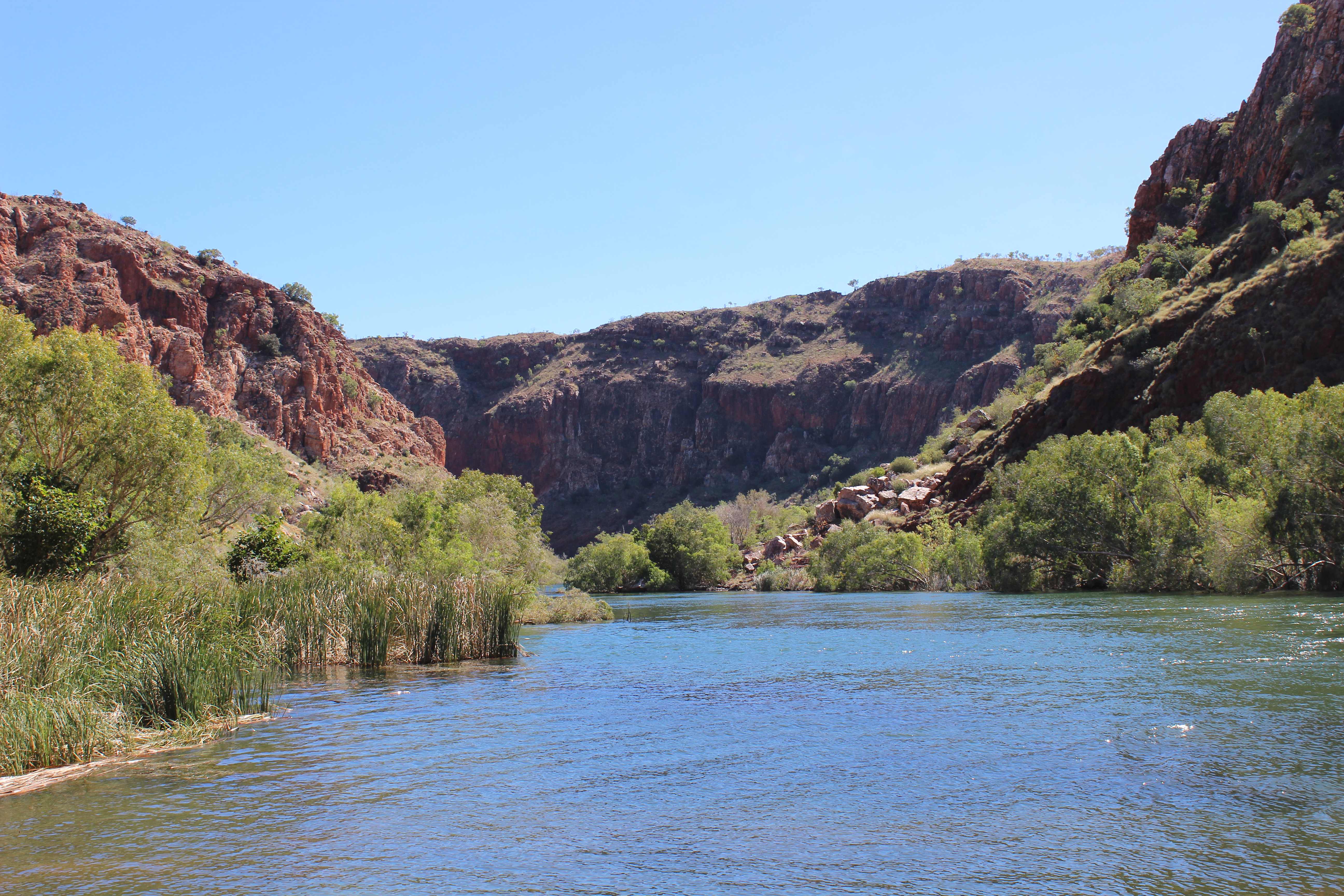
After travelling overseas the thing that strikes me about Australia is that you can drive for days and practically see no form of civilization, apart from the occasional roaming cow or sometimes a roadhouse. Particularly in the outback regions in the arid centre of Australia and the north west of West Australia there are vast distances in between towns and cities. This is what is so remarkable about this magnificent country that I live in – its stark endless terrain and wide open spaces.
In part two of Australian Places: Remote and Remarkable I am taking you across the Bass Strait to Tasmania and also exploring a few other little known places in the Northern Territory, West Australia, Victoria and Queensland.
Bay of Fires is around 200 kms north of Hobart, 100 kms east of Launceston and extends from Binalong Bay to Eddystone Point on Tasmania’s north-east coast. So called The Bay of Fires, because explorers from the ship saw fires blazing lit by native Aborigines, when they passed these shores. And here I was thinking it was because of the orange lichen coloured rocks that are everywhere, which could be likened to blazing shores.
You can drive on a surfaced road from Binalong Bay as far as The Gardens, with scenery that will simply take your breath away unfolding before your eyes, then the road is gravel all the way to Eddystone Point.
Along the way you can stop and stroll along the whitest of white sandy beaches, swim in the crystal clear ocean water, and feel like you’re the only person to have ever set foot here. There are several free campsites along the coastline where you can set up camp right alongside the picturesque beaches.
Further north of the Bay of Fires coast is the Mt William National Park where there is even more scenic coastline with granite boulders and long sandy beaches.
Mataranka is known as the ‘Capital of the Never Never’. This area was home to Aeneas and Jeanie Gunn, who wrote the famous book about Elsey Station titled ‘We of the Never Never’. You can visit the replica Elsey Station homestead and even see the life-size statues of the characters from ‘We of The Never Never’ in the park in town.
Mataranka, which sounds a bit like a Latin dance, sits on the upper reaches of the Roper River, an hour’s drive south-east of Katherine in the Northern Territory.
What is remarkable about Mataranka is that it is home to the natural hot spring pools of both Bitter Springs and the Mataranka Thermal Pools. Who would ever think there would be natural thermal pools in the middle of Australia?
Possibly one of the West’s best kept secrets, Lake Argyle is around 70 kms from Kununurra in The Kimberley, West Australia. The 35 km drive through the Carr Boyd Ranges is nothing short of spectacular on the way into this massive water catchment area.
Nestled amongst a billion year old landscape of the Carr Boyd Ranges, Lake Argyle has a surface area of over 1,000 square kilometres, a shoreline stretching 900 kilometres and holds 18 times more water than Sydney Harbour.
Lake Argyle is home to an estimated 25,000 freshwater crocodiles, some 150,000 waterbirds and 26 species of fish. Then there are the flying foxes, the wallabies, the frilled neck lizards and more.
It maybe remote, but Lake Argyle Resort offers a range of accommodation from lake view villas, cabins, outback safari huts to caravan and camping sites. An infinity edge pool which overlooks the rocky escarpments and the vast expanse of lake has one of the best views in the world. The resort also boasts a shop, cafe/restaurant, bar and entertainment, including trivia nights, singer/guitarists and the Sunday night roast dinner.
The tropical rainforest region of The Daintree, encompassing Cape Tribulation, is in Far North-East Queensland north of Cairns, and covers an area of around 12,000 square kilometres. It is the largest continuous area of tropical rainforest on the Australian continent. Along the coastline north of the Daintree River up to Cape Tribulation, tropical rainforest grows right down to the edge of the sea, which is spectacular.
There are plenty of educational boat cruises that go down the Daintree River that give visitors a commentary of the river and its eco system. There are a large amount of estuarine crocodiles, endemic birds to the region, frogs, pythons, tree snakes, butterflies and insects, some of these are rare and only found in this area. Also many different species of mangroves as there are 31 species in this single estuary.
The drive to Cape Tribulation entails catching a vehicular barge across the Daintree River. It is an incredibly scenic drive through the rainforest with many places to stop and take in the panoramic views of where the rainforest meets the ocean. Be on the lookout for the rare cassowary bird as there were road signs everywhere indicating that they were prevalent in this area.
A largely untouched and uncommercialised area, Cape Tribulation, consists of a headland where the rainforest meets the ocean. The locality contains a small number of bed and breakfast eco lodges, tourism resorts and backpacker hostels. There are a few walking tracks including the Dubuji Boardwalk which is a walking trail from the main highway to the beach that has toilet and picnic facilities.
Once you reach the Cape the road beyond to the Far North and Cooktown is unsealed and recommended for 4WD vehicles only.
Located on the Great Ocean Road and around 21 kms south-west of Portland, are some of the highest coastal cliffs in Victoria overlooking the deep-blue waters of Bridgewater Bay. Cape Bridgewater stretches in a perfect crescent around the rim of a huge, ancient volcano crater.
Here you can take in the surreal landscape of the petrified forest which looks like a forest of tree roots turned into rock or see the sea swell up into a towering spray at the blowholes. There are also hundreds of wind turbines at the wind farm perched atop the cape.
You can also observe the large breeding colony of fur seals at the cape from a look out above.
A small hamlet, nestled between a long sandy beach and towering cliffs, Rapid Bay on the Fleurieu Peninsula hasn’t succumbed to the flurry of beachside development. The approach into the bay is down a steep winding road, with spectacular views across the gulf.
Rapid Bay is a popular dive site because of its pristine waters and has a long jetty that is great for fishing. For history buffs, there is a boulder here, which Colonel William Light (South Australia’s founding father), carved his initials after he first stepped ashore from his ship ‘The Rapid’.
The town of Second Valley is reminiscent of a Cornish fishing village, hugging the edge of Yankalilla Bay. The rugged geological rock formations and steep coastal cliffs help make Second Valley unforgettable. Same goes for the Old Mill, on the main road into this tiny town, which has now been converted into a restaurant and reception venue.
Its protected waters provide scuba divers and snorkellers with a memorable experience and anglers know it best for the fine fishing.
If you are after a unique diving experience then the wreck of the HMAS Hobart, which was scuttled four nautical miles west-north-west of Marina St Vincent in Yankalilla Bay, is a great dive spot because of its accessibility to the ship.
Camooweal proudly declares itself as being the ‘Gateway to the Northern Territory/Queensland‘, located just over the NT border in outback Queensland.The surrounding district is honeycombed with rare sink holes and caves, dating back to the Cambrian Period, about 500 million years ago. Those visitors experienced in serious caving will discover a whole new world beneath the Camooweal region.
However we didn’t come to Camooweal for the sink holes, but for the magnificent Georgina Billabong located just outside of town. Here you can perch on a comfy chair, with a pair of binoculars and a camera on the banks of the waterlily laden Billabong to view the magnificent waterbirds including brolgas, egrets, pelicans, swans, ducks, corellas, kytes and white cockatoos.
There are also heaps of free camping spots along the Billabong and is a tranquil place to camp for a few days.
In Australia we are truly blessed with so many places that are geographically remote and remarkable with their natural beauty. I believe you could travel for years and still not see all the uniqueness that our country has to offer. And you don’t even need a 4WD to access these wondrous places.
Linking up with Travel Photo Thursday
Kathy was a 50 something year old when she started up this blog 6 years ago, but has since turned over another decade and is now in her early 60s. She is married with two adult children and lives on the Tweed Coast of New South Wales, Australia. Kathy enjoys living life to the fullest and loves to keep fit and active by maintaining a healthy diet and exercising regularly. Some of her interests include reading, photography, travelling, cooking and blogging! Kathy works part-time as a freelance writer but her real passion is travelling and photographing brilliant destinations both within Australia and overseas and writing about it.
Comments are closed.


Johanna
September 30, 2016My goodness we live in a beautiful country and your photos do it ultimate justice too. You’ve reminded me of some favourite places and prompted me to go to more … ohh, I think an adventure is called for :)
Kathy
September 30, 2016We do indeed live in a spectacular country. There is so much to see and do in our big backyard! I’m sure we will be off doing some more exploring in the near future. :)
Ruth
September 30, 2016Cathy, I like the way you feel about your country. I like the way Australia keeps surprising you with its beautiful landscapes. The places you have presented in here are incredible. So much variety!
Kathy
September 30, 2016I do feel very passionate about my country. Like you say there is so much diversity from east to west and south to north. There are heaps of wondrous landscapes everywhere you look. :)
Jackie Smith
September 30, 2016An amazing array of places you’ve shown us! Thanks so much for introducing me to so many and reminding me again of just how vast Australia is!
Kathy
September 30, 2016You are most welcome Jackie. There’s so much beauty in our vast country and I love to bring it all to my readers. :)
Jan Wild
September 30, 2016Some beautiful spots there Kathy and I agree with Jo, your photos are beautiful. I have such fond memories of spending a week staying up in the Daintree, it is such a magical place.
Kathy
September 30, 2016The Daintree is a fascinating part of Far North Queensland. So much greenery and lushness in the vast rainforests. Plus a lot of crocs! We have thoroughly enjoyed our two trips up this way. :)
budgettraveltalk
October 5, 2016Your Bay of Fires photo is amazing. Bitter Springs – that water is super clear and a nice blue too. The Lake Argyle collage really captures it and the Infinity Pool makes me wish I was there so much. I’d love to fish off Rapid Bay jetty and snorkel at the dive sites. Such an interesting post Kathy, it makes me want to pack up and go! Thanks for linking up.
Kathy
October 6, 2016Thanks Jan. The Bay of Fires was absolutely stunning so it wasn’t hard to get a good photo. There are so many great places in Australia that people have possibly never heard of and I love to show them off. It makes me want to pack up and go back! :)